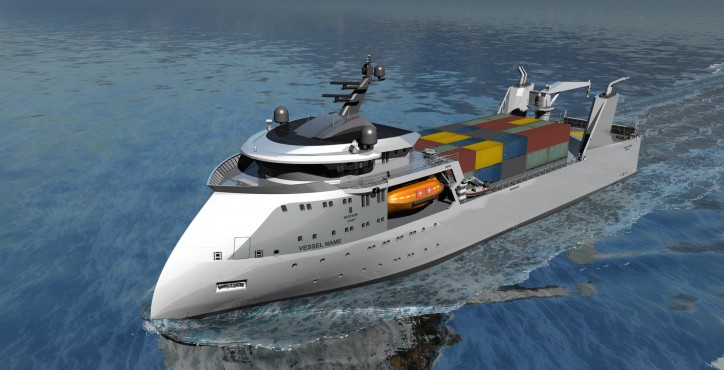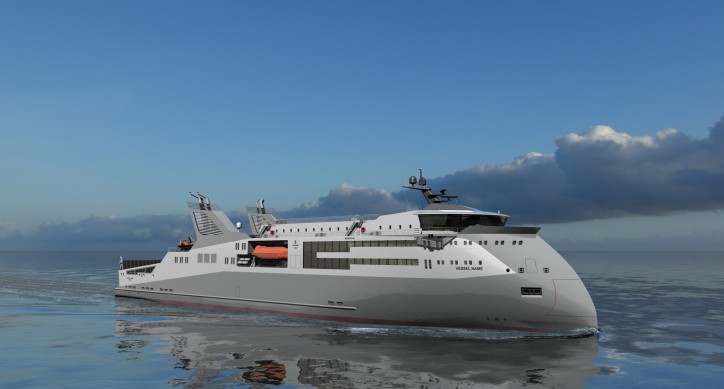Ulstein has developed a range of X-BOW® vessels for the RoPax market. The portfolio is based on Ulstein ‘compact concept’. This concept increases the competitiveness of such vessel designs by higher revenue making at lower financial and operational costs.
The X-BOW® is one of Ulstein’s contributions to cleaner and more sustainable shipping operations. Introducing the X-BOW on RoPax vessels is a natural design development.
Environmental footprint
Many RoPax vessels operate in harsh areas, for which the X-BOW was originally designed. An X-BOW vessel at the same speed and weather conditions will use less power than a conventional bow vessel. The X-BOW hull line is a proven solution used in a number of different market segments, and leads to improved seakeeping, and reduced speed loss and fuel consumption, hence a reduced environmental footprint.

Safety and comfort
The seakeeping behavior of RoPax vessels is important to the integrity of the cargo and the comfort of the passengers. In many cases, the movements of a vessel call for a slow-down. This may in turn challenge the regular scheduling of a vessel. However, the X-BOW RoPax vessels will not need to slow down even in fairly rough weather, which help to keep schedules. This has been proven in offshore vessels, where more than 90 vessels are already in operation.
Flexibility and efficiency
The ‘compact’ concept of shorter, wider and slower design solutions, leading to high capacity vessels and less expensive newbuilds.The concept introduces higher flexibility with respect to vehicle logistics on board the vessels, a flexibility which is much appreciated by customers of the RoPax industry.
The propulsion system of the vessel can be designed according to the vessel’s operational profile and set schedule. A smaller propulsion plant will contribute to lower capital investments (CAPEX), less maintenance (OPEX) and reduced energy consumption (VOYEX), making the operation of the vessel more efficient.
Further, and equally important, power energy consumption improve the greener profile of the vessel and its operations.
The ULSTEIN ZED solution can also be used on RoPax vessels to achieve zero emissions for longer periods of time when at port or in environmentally sensitive waters
“RoPax is a segment in growth, where we will see fleet renewals in the years to come. We have for some time worked to integrate Ulstein’s design mindset into a range of RoPax vessels. These vessels are all equipped with the X-BOW hull feature, a natural choice when operating in climatically rough conditions,” says COO Design & Solutions, Tore Ulstein.

“Our RoPax vessel designs are optimized according to market needs and will be constructed in series for the volume market,” states Tore Ulstein. One potential country for the ship construction is China.
“We have had offices and site teams in Shanghai and Ningbo for many years, and our people have long experience in system integration and site follow-up,” says Tore Ulstein. He continues:
“More than half of the more than 100 Ulstein designs which have been built outside Norway, have been constructed in China with Ulstein site teams present. We have good relations to our Chinese partner yards and are currently in dialogue with several yards on the construction of these RoPax vessels.”
An approach which combines the best of two cultures
Design of volume series has been carried out successfully in Ulstein several times, last seen with a series of up to ten expedition cruise vessels of which all will be built in China. With Norwegians and Chinese working side by side in our China-based companies, we can offer an understanding of both cultures which helps to smooth the language barriers and cultural challenges found in all walks of international business life.
Prototype yard in Norway
The RoPax range have been developed for volume construction. For clients who request a higher degree of customisation, Ulstein has their own prototype yard, Ulstein Verft, in Norway.
Source: Ulstein